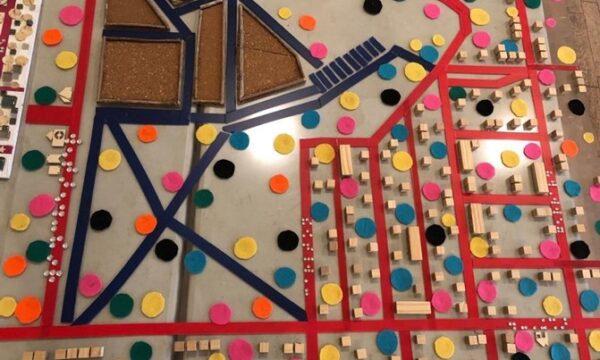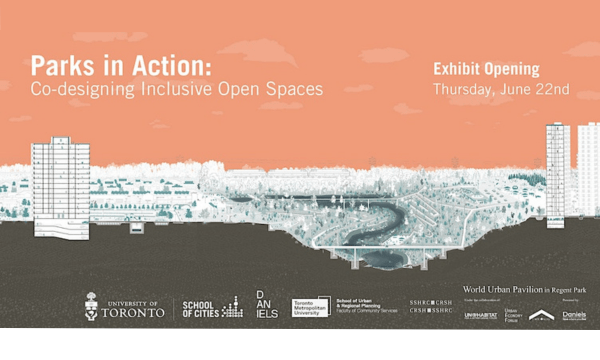One of the challenges of our project is that quality in one’s built environment cannot be measured – not directly. As our last public session indicated, there are many possible definitions and aspects of quality, some of which include equally nebulous concepts like safety and inclusivity that can only be observed and measured indirectly, and are often based on residents’ perceptions rather than objective numbers. One frequently-used indicator of quality in the built environment is walkability, especially in urban environments where greater walkability is correlated with improvements in public health, [1] psychological wellbeing, [2] and lower/less frequent exposure to environmental hazards (e.g., pollutants). [3] Efforts to increase or improve the walkability (and, by extension, overall quality) of urban neighbourhoods typically include or aim for things like decreasing traffic congestion, lowering crime rates, and increasing physical activity which may not always be relevant in the rural context.
Using the walkability example, while walkability scores tend to be lower overall in rural neighbourhoods than in urban, most studies indicate that rates of walking, and participation in physical activity more generally, are broadly similar between rural and urban residents. [4] This suggests that walkability is not strongly correlated with activity levels in rural populations – or, at least, that measures of walkability designed for and applied to urban settings are largely irrelevant in the rural context, perhaps because walkability and its associated features are perceived differently by rural residents. That is, because “many of the features assessed in urban areas are relatively rare in rural areas (eg, [sic] sidewalks, streetlights), thus necessitating a modified set of domains.” [5] While it is certainly not the case that every measure of quality in urban environments must be reinvented or reimagined for rural ones, it does highlight the fact that these localities, and likely also the lifestyles and behavioural patterns of the people living and working in each, are very different and cannot be assessed in the same manner.
Rural community members and stakeholders have emphasised this point repeatedly in past discussions and consultations – discussions that have also revealed the unique character of the many rural communities across Alberta. Each rural community has its own needs, desires, strengths and benefits, etc., and they do not always share the same challenges or characteristics merely on the basis of shared rurality. As such, urban planning metrics and conventions cannot always be (usefully) applied to rural places, and those that have been successfully applied to one cannot be assumed to be appropriate for all others. It is therefore critically important to obtain input from rural residents to ascertain and effectively address problems with or negative aspects of the rural built environment – including children and similarly vulnerable groups, those whose voices are not often heard in public consultations but who are very much affected by the outcomes.
Much work has been done in comparing rural and urban environments, lifestyles, and wellbeing, but typically coming from the perspective of urban researchers working under the tacit assumption that urban life is ultimately better and more desirable. Far less work has sought to evaluate rural communities on their own terms and without comparison to larger population centres. Though some measures of quality are applicable to any type of built environment, it is nevertheless clear that some – as in the example of walkability – must be altered significantly or perhaps replaced with altogether new ways of measuring quality if they are to be valuable outside of the urban context.
To learn more about the research site led by Athabasca University, click here.
REFERENCES
[1] See e.g. Lucy Dubrelle Gunn, Suzanne Mavoa, Claire Boulange, Paula Hooper, Anne Kavanagh, and Billie Giles-Corti, ‘Designing healthy communities: creating evidence on metrics for built environment features associated with walkable neighbourhood activity centres’ in International Journal of Behavioral Nutrition and Physical Activity, xiv, no. 1 (2017), pp. 164-176.
[2] See e.g. Kelly J. Watson, ‘Establishing psychological wellbeing metrics for the built environment’ in Building Services Engineering Research and Technology, xxxix, no. 2 (March 2018), pp. 232-243.
[3] Julian D. Marshall, Michael Brauer, and Lawrence D. Frank, ‘Healthy neighbourhoods: walkability and air pollution’ in Environmental Health Perspectives, cxvii, no. 11 (July 2009), pp. 1752-1759.
[4] Michael C. Robertson, Jeojoon Song, Wendell C. Taylor, Casey P. Durand, and Karen M. Basen-Engquist, ‘Urban-rural differences in aerobic physical activity, muscle strengthening exercise, and screen-time sedentary behavior’ in The Journal of Rural Health, no. 34 (2018), pp. 401-410; also Paul McCrorie, Rich Mitchell, Laura Macdonald, Andrew Jones, Emma Coombes, Jasper Schipperijn, and Anne Ellaway, ‘The relationship between living in urban and rural areas of Scotland and children’s physical activity and sedentary levels: a country-wide cross-sectional analysis’ in BMC Public Health, xx (2020), pp. 304-315 and Anges G. Bucko, Dwayne E. Porter, Ruth Saunders, Lynn Shirley, Marsha Dowda, and Russell R. Pate, ‘Walkability indices and children’s walking behavior in rural vs. urban areas’ in Health and Place, lxxii (2021), pp. 102707-102713.
[5] Kathleen Scanlin, Regine Haardoerfer, Michelle C. Kegler, and Karen Glanz, ‘Development of a pedestrian audit tool to assess rural neighbourhood walkability’ in Journal of Physical Activity & Health, xi (2014), pp. 1085-1096.



